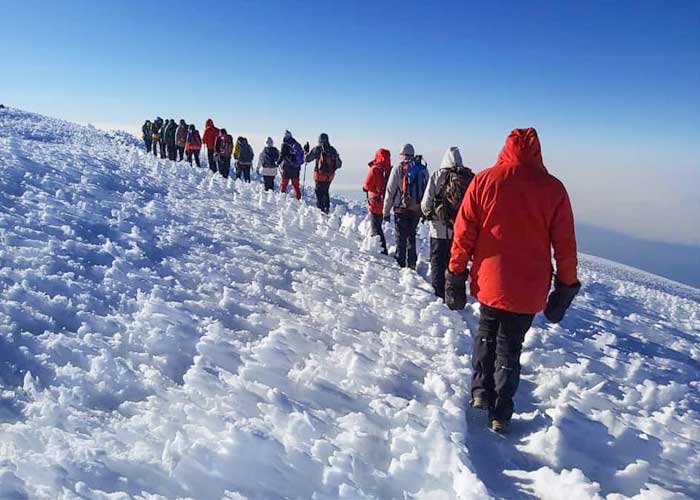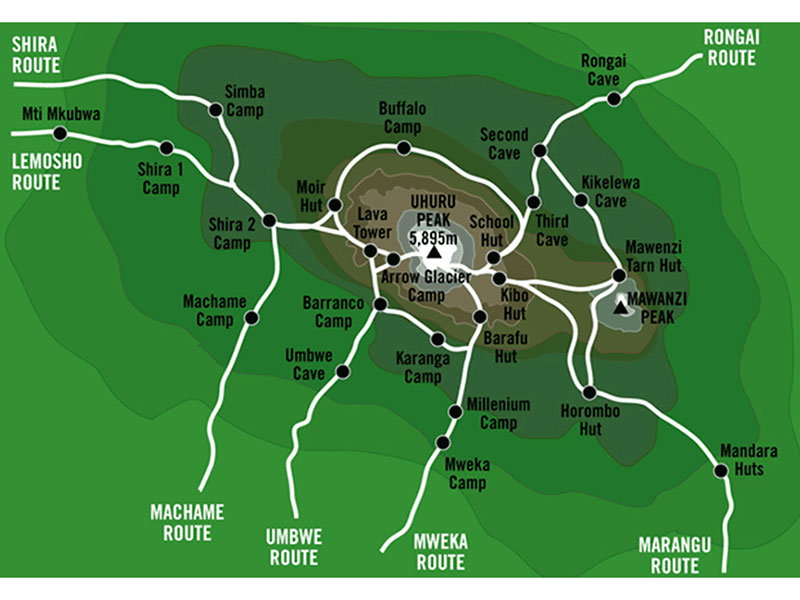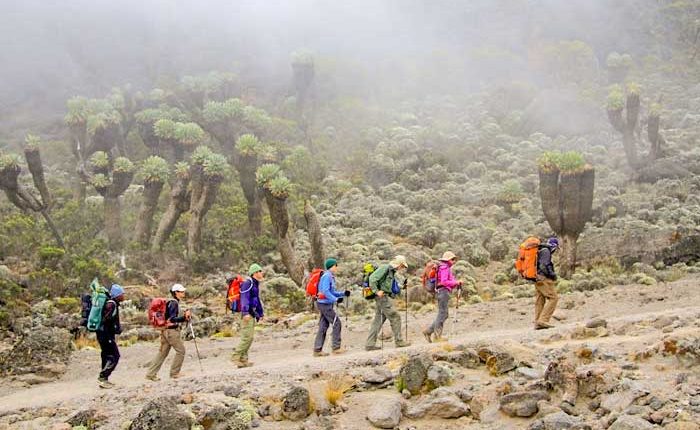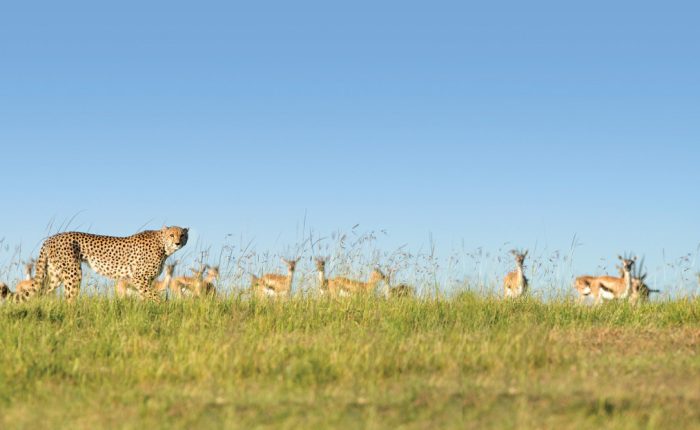Adding item to wishlist requires an account
Don't have an account? Create one.
Why Book With Us?
- No-hassle best price guarantee
- Customer care available 24/7
- Hand-picked Tours & Activities
- Best Safari Guides
Get a Question?
Do not hesitate to give us a call. We are an expert team and we are happy to talk to you.
+255 742 688 249
info@safarinugguets.com
Rongai Route – 6 to 7 Days Kilimanjaro Climbing
- 6 to 7 Days
- Max People : 25
- Min Age : 12+
- Pickup: Airpot
Trek the gentler northern approach to Mount Kilimanjaro
Your guided trek on the Rongai Route begins on the northern side of Mount Kilimanjaro. This approach is not as busy as other routes and provides unique views of Kenya on your first day.
Your experienced guides, porters, and cooks will help you along your trek as you hike the highest peak in Africa.
Rongai Route has a reputation for being the easiest path to hike Kilimanjaro, but it’s not without its challenges. The strenuous climb through heavy scree to Gilman’s Point will banish the word easy from your vocabulary.
You’ll be trekking through wildly different landscapes and experiencing everything from the lush rainforest to majestic moorlands and dramatic alpine deserts.
None of the amazing sights along the way will be able to compare to the incredible views from the top of Uhuru Peak! Your guided trek will be complete at the Marangu Gate, where you’ll meet your ride back to Moshi.
Departure & Return Location
Arusha town (Google Map)
Departure Time
3 Hours Before Flight Time
Price Includes
- Airport Pickup & Transfer
- 3 Nights Hotel Accommodation in Arusha
- Kilimanjaro Tour Guide
- Entrance Park Fees
- Transport to and from the airport
- All meals per itinerary (B=Breakfast, L=Lunch, D=Dinner)
- All tours and entrance fees per itinerary (unless listed as excluded)
- Emergency Oxygen (2L canister)
- Oximeters
- All transportation and transfers per itinerary
- Camping fees
- Tents, foam sleeping pads, cooking equipment, and eating utensils
- Rescue fees (as required by national park)
- Certified, experienced, English-speaking guides for all routes
- Salaries for all crew members
Price Excludes
- International and domestic flights
- Beverages and alcohol
- Any Private Expenses
- Tips for guides, drivers, hotel staff
Complementaries
- Umbrella
- Kilimanjaro Coffee
- T-Shirt
Highlights of the 6-Day Mount Kilimanjaro on Rongai Route
- Experience the stunning views from Gilman’s Point and Kilimanjaro’s Uhuru Peak.
- Enjoy warm healthy meals and quiet campsites as you approach the summit.
- Birdwatch and look for monkeys in two different forest environments.
- Experience a more gradual ascent and the quieter paths on the first days of the Rongai Route.
Itinerary Day to Day
Day 0Arrive for your pre-trek briefing
After your arrival at Kilimanjaro International Airport in Moshi and transfer to your hotel, you’ll meet with a representative for a trek briefing and equipment assessment. This will also give you ample time to look after any additional equipment rental you may want.
Overnight Location: Hotel in Moshi
Distance: None
Meals: None
Day 1Begin your trek to Simba Camp
You’ll be picked up from your hotel in Moshi for the drive to the charming wooden village of Nale Moru. On your way to the trail, you’ll stop at the Marangu Gate to complete the registration forms, then your hike begins. This path is drier than some of the other routes, so you’ll be quite comfortable as you hike through fields and a pine forest. You’ll break through the trees when you arrive at Simba Camp and enjoy expansive views of the Kenyan plains.
Overnight Location: Camping on Mount Kilimanjaro (2,650m / 8,695’)
Distance: 3 to 4 hours, 6 km, 652m of elevation gain
Meals: Breakfast, lunch, dinner
Day 2Hike through the moorland to Second Cave
This morning you’ll trek through the heather of the moorland and up to Second Cave Camp. This is your stop for the night, so you can enjoy the stunning view of Kibo Peak and the eastern ice fields.
Overnight Location: Camping on Mount Kilimanjaro (3450m / 11,318’)
Distance: 3 to 4 hours, 6 km, time, km, 800m of elevation gain
Meals: Breakfast, lunch, dinner
Day 3Trek from Second Cave to Third Cave Camp
There are a few different paths from here, so you may find different hikers splitting off in different directions. Enjoy the quiet wilderness as your trail steadily ascends to Third Cave Camp. You’re now at nearly 4000m elevation, so make sure to stay hydrated and pay attention to any side effects you might be feeling from the altitude.
Overnight Location: Camping on Mount Kilimanjaro (3,930m / 12,983’)
Distance: 2 to 3 hours, 9 km, 430m of elevation gain
Meals: Breakfast, lunch, dinner
Day 4Hike to the bottom of the Kibo Crater
Today you’re crossing the rocky alpine desert towards Kibo. Its snowy crater wall will be looming above you when you arrive at Kibo Hut Camp. Dinner will be served early so you can squeeze in as many hours of sleep as you can. Tomorrow will be an early morning and a long day!
Overnight Location: Camping on Mount Kilimanjaro (4,703m / 15,430’)
Distance: 3 to 4 hours, 5 km, 870m of elevation gain
Meals: Breakfast, lunch, dinner
Day 5Midnight trek to Gilman’s Point and final ascent to the summit
Have your warm layers and your headlamp ready, it will still be dark and cold when you leave your tent around midnight. It’s a challenging hike through heavy scree or snow all the way to Gilman’s Point. As dawn breaks, you’ll begin your final push to the top of Uhuru Peak. When you’ve celebrated climbing the tallest mountain in Africa, it’s time to take some photos and start the hike down. Your day is only halfway over, as it’s a long way down to Horombo Hut Camp.
Overnight Location: Camping on Mount Kilimanjaro (3,720m / 12,303’)
Distance: 12 to 16 hours, 21 km, 1195m of ascent, and 2175m of descent
Meals: Breakfast, lunch, dinner
Day 6Descend to Marangu Gate and drive back to Moshi
Today you’ll be descending from the arid alpine desert through the familiar moorland and into the forest. The trail will be dramatically different from the one you experienced on your first day, as now you’re in the rainforest. It can be wet and very muddy on the last section of the trail, so be prepared. You may catch a glimpse of some monkeys if you keep your eyes on the trees. After you’ve collected your summit certificate at Marangu Gate your driver will be waiting to drive you back to your hotel.
Overnight Location: Hotel in Moshi
Distance: 4 to 5 hours, 20 km, 2000m of descent
Meals: Breakfast, lunch, dinner
Day 7Goodbye!
Today, after a good night’s sleep, you’ll head to the airport for your departure flight. Goodbye, Kilimanjaro!
Overnight Location: None
Distance: None
Meals: Breakfast
Kilimanjaro Route Map
FAQ
1) How much time do I need to climb Mount Kilimanjaro?
We recommend a minimum of eight days from the USA and Europe, although some people may wish more time for the trip. We can customize itineraries or routes to offer more days in the park(s). Some people may wish to climb nearby Mount Meru as well. If you have more than eight or nine days, you can choose any of the main routes on the mountain and still have time for a wildlife safari before or after your trip.
2) What is the best time of year to climb Mount Kilimanjaro?
You can climb any month of the year. At lower elevations, April, May, and November are quite wet while March and June are transitional months. August and September are the coldest and driest months. January, February, July, August, and September are all popular climbing months.
3) How far do I hike each day?
We can measure each day in walking hours rather than kilometers. Most days, other than the summit day, will begin with breakfast around 6:30 AM and departure at 7 AM. You will walk four to five hours with a break for lunch followed by another hour or two of hiking in the afternoon. These days are not long or difficult and you will be advised to walk slowly.
4) Why do we make the final ascent in the pre-dawn darkness?
Most groups will start for the summit on ascent day around 11 PM to midnight, depending on the perceived fitness of the group, the weather, and the route. The pre-dawn hours are ideal to start the ascent to the summit as it is cold but also calm and clear. It is rare to find cloudy weather at the summit at dawn any time of year and at dawn, you have the best view.
On the other hand, if you leave in the early morning, it could be very windy and the ascent becomes more difficult. The ascent day is a long hiking day, so it is better to start early and walk slowly. It can take up to 15 hours to reach the summit and descend to the camp for that night.
5) How much weight will I have to wear and where can I leave unnecessary luggage?
You will simply carry a day pack of about two to four kilograms, although some people carry more or less. Your gear (not to exceed twelve kilograms) will be placed inside a waterproof duffle at the trailhead and a porter will carry this for you. If you have things that you do not need on the climb, you may leave a bag behind at Arusha.
6) What kind of staff will accompany me on the climb?
The usual ratio is three or four local staff for each climber, although small groups may have four or five staff per climber. The staff usually consists of an English-speaking guide or guides, a professional cooker, and gear-carrying porters. We encourage you to interact with your staff. They are all trustworthy, local people who have grown up in the shadow of the mountain. Many of them have climbed the peak a hundred or more times.
7) What is provided and what do I have to bring?
We provide tents, camping gear, food, utensils, and leadership. You should bring your own sleeping bag, water system, personal clothing, light duffle bag, and day pack. Hiking poles can be rented.
A packing list is provided to all climbers, along with our pre-departure packet:
• 1 mountaineering sleeping bag (usually a below 10-degree rating or better is recommended)
• 2-3 liters water canteen (sturdy plastic or steel)
• 1 LED flashlight with spare batteries
• 1 Pair of comfortable trekking boots
• 1 towel
• 2 pairs of thick thermal socks and several pairs of regular socks
• 2 fleece jackets
• 1 down jacket or long-sleeved wind-breaker (down jacket is unnecessary if you have good fleece jackets)
• 1 set of thermal underwear (i.e. thermal vest and long jeans)
• 2 pairs of trekking trousers
• 1 waterproof jacket
• 1 pair of waterproof trousers
• 1 balaclava or ski-mask
• 1 sun hat
• 1 pair of sunglasses
8) What kind of tents will I sleep in? What are the huts on the Marangu Route like?
Your tents are mountain-style, double-walled, mosquito-netted, and durably-floored with waterproof material. While technically rated as three-person tents, they accommodate two people very comfortably. Tents are erected and packed up by the portering staff. There is enough space for tall people to stretch out and room for your gear within the tent. On the Marangu Route, the huts are just large enough for four bunks built against the walls of A-frame cubicles. Tall hikers will feel cramped. Gear is stored on the floor. Wash and toilet facilities are shared and are outside of the bungalows.
9) What is the food like?
Breakfast includes tea, coffee, milk, eggs, toast, porridge, cereals, bread, fruits, bacon, sausages, etc.
Lunch is a picnic lunch on the way the first day while it is hot lunch the next day with hot soups, bread, vegetables, fruits, salad, cookies, beef, chicken or fish, potatoes, pasta, or rice with sauce.
Dinner starts with hot soups, followed by the main course (pasta or rice, meat), desserts, and ends with hot drinks.
10) Drinking water—is it safe and is there enough for all climbers?
You will have enough drinkable water during the trip. To keep your system running normally, we recommend you bring two bottles and use tablets to purify water (you can buy tablets in Arusha).
11)What happens if some members of the party need to turn back before the summit?
No one is forced to go on. There is always enough staff to split the group according to needs and regroup later at the camp. Most people have no trouble reaching the highest campsite. If some party members decide not to climb the final distance to the peak or cannot proceed at any point in time, they can wait for the other group climbers to come back or can go down with a guide following the same way or take a lateral path to the descent route.
12) What are the health issues on Mount Kilimanjaro?
You must arrive healthy and fit. A simple cold or another respiratory sickness can become worse during trekking. There is no malaria risk on the mountain and insect bites are very rare.
13) What kind of help is available in case of an emergency?
We always have a first aid kit with us and guides are well trained on first aid. Serious injuries are very rate and Kilimanjaro National Park has a rescue team in case of emergency.
14) Is bottled oxygen necessary or available on the climb?
Bottled oxygen is not routinely available on this climb and is not included in the price of the trip. The most immediate treatment for serious altitude sickness is rapid descent, which is always possible on Mount Kilimanjaro. Virtually no climbers on the mountain carry oxygen. If upon reaching the final campsite before the ascent your guide judges you to have serious symptoms of altitude sickness, you will not be permitted to attempt the final climb. Oxygen may be available on an emergency basis or at an added cost, but not as an aid for climbers who have not acclimatized adequately on their own.
15) Do I need to get any vaccinations before I leave?
Check with your doctor and the Center for Disease Control (CDC) for current recommendations. None are required for entry to Tanzania from the USA and Europe or for re-entry to the USA and Europe. If you come from a yellow fever endemic country by road, proof of vaccination is required.
16) Will I need a VISA?
Yes, you can obtain it in advance or on arrival in Tanzania at the international airport.
17) Why can I find cheaper prices for the same route?
The major sources of cost variations are the money spent on food, off-mountain accommodation, porter and guide wages, tents, and the cost of getting to the mountain.
Safari Nuggets is determined to provide the best food, best guides, and porters, best tents and equipment, top quality before-and-after-climb accommodation, a full professional pre-climb orientation, insurance for all staff, and inclusion of all park permits, meals, transfers, and local hosting costs. On some of the least expensive trips, food is minimal and often prepared by frying. As guides and porters are expected to cover part of their wages with tips, these companies cannot attract the best staff. Often, they do not provide full warm clothing to staff. The mountain is hard on tents which are expensive in Tanzania, meaning that tents on cheap trips are often worn or dirty.
Our approach is not to provide the cheapest trip, but rather to do everything we can to increase the likelihood you will reach the summit and enjoy the overall experience with a staff of people who are well qualified and compensated for the extraordinary assistance they provide to you.
We invite you to report your issues/requests/questions to the Safari Nuggets office or your guide during the hiking.
Related Tours
Design your own trip
Get in touch with our Tour Consultant to start planning your own unforgettable experience
Contact us
- +255 742 688 249
- info@safarinuggets.com


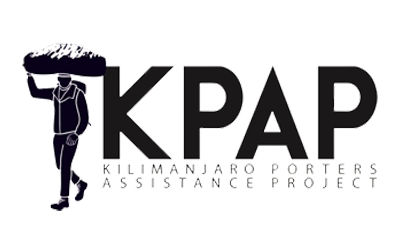
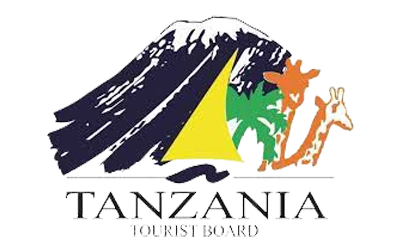
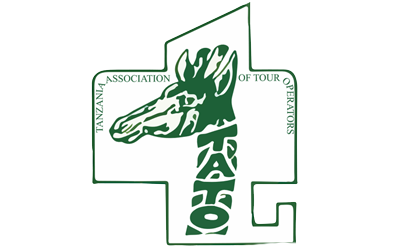
© 2023 Safari Nuggets – All Rights Reserved.

